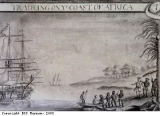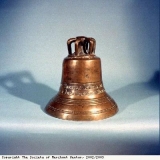Organisation of the slave trade, Africa
The first Africans taken to Europe against their will were kidnapped by the Portugese in the 15th century. They would have been forced to work as domestic servants or on the sugar plantations owned by the Portuguese in the Canary Islands in the Atlantic Ocean and the island of Madeira in the Mediterranean sea. Most of the millions of Africans transported to Europe and the Americas, however, were bought from African traders. The slave trade became a well-organised business. The local African rulers controlled the trade and allowed the European ship’s captains to conduct their business at the coast of West Africa. The African traders would have slaves to sell to the Europeans at the coast, or could get them on demand from traders inland.
The detail taken from the drawing The Southwell Frigate shows the close relationship between European captains and local African chiefs and traders. The two men are clasping hands in a handshake. But trust between European and African traders was fragile. There are many accounts of captains imprisoning, whipping and enslaving the traders with whom they dealt. There are also accounts of African traders cunningly playing off traders from different European countries in order to get the highest price for their slaves. The Calabar Bell, seen here, was a gift from the Bristol slave trader Thomas Jones to his African trading partner called Grandy Robin John in Old Calabar, on the coast of what is now Nigeria. The supply of slaves on this part of the coast was controlled by the important African traders in the area, like Robin John. Gifts were given (and asked for) to keep in the good books of a trading partner.
“The trade of slaves is the business of kings, rich men and prime merchants” wrote the French trader, Jean Barbot, in about 1683. He meant that the buying and selling of slaves was mainly the business of the wealthy and high-ranking people in society. The local African ruler might also have been the slave trader, but not all rulers ran their own business affairs. Often the traders themselves were slaves, acting on behalf of their owner. Benin was a large West African state in the area that is now the country of Nigeria. The Oba or King of Benin ‘did not deign to trade directly’. Instead he handed over all business affairs to his wives and slaves. The captains of the European slave ships had to establish a working relationship with the local chiefs and traders.
Not all African rulers wanted to sell slaves, but it was hard to resist, because there were gains to be made. Queen Nzinga in Angola,West Africa, fought hard against the trade. She was against her own people being sold into slavery, however she is said to have sold her enemies into slavery. This practice was common amongst African countries that were involved in slave trading. In contrast, the traders in the Calabar region of what is now Biafra in Nigeria embraced the new trading opportunities and the wealth it could bring.




